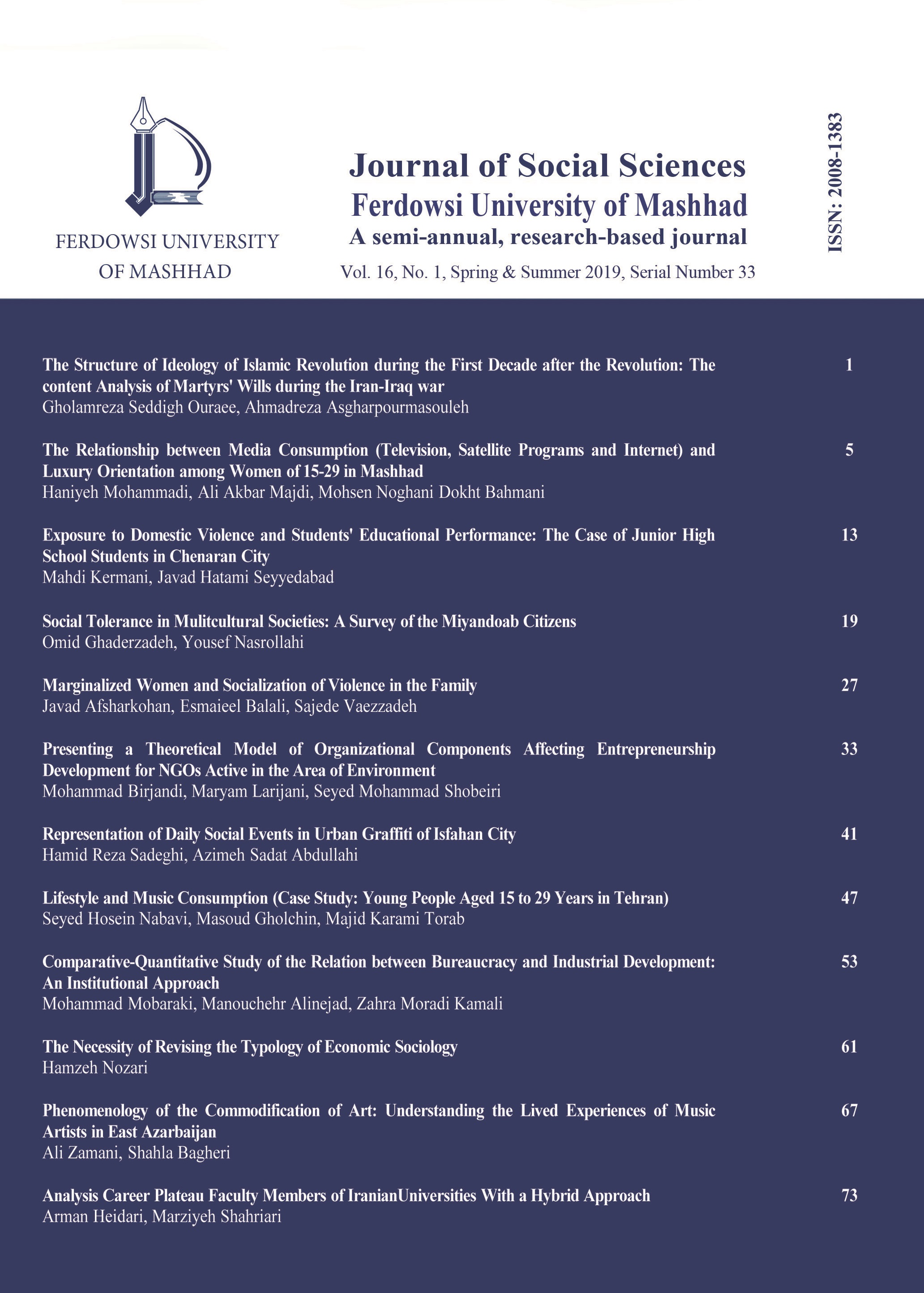Document Type : Scientific-Research
Authors
Ferdowsi University of Mashhad
Abstract
Extended Abstract
Introduction
In the modern age, media has become an integral part of our lives and sources of information that influence people. One of the behavioral aspects that can be influenced by the media is the pattern of people’s consumption in everyday life. Since media programs, movies, advertisements, TV series, etc. are disseminating consumerist and luxury oriented values. They can influence people’s desire for consumption and luxury. Women have been studied in this research because of the central and influential role they play in life and particularly in family consumption pattern. The aim was to examine women’s extent of media consumption and luxury orientation, and to answer the question that whether there is a significant relationship between media consumption (TV, Satellite programs, and Internet) and luxury orientation among the women of 15-29 years old in Mashhad?
Review of Literature
In this research, the theories of conspicuous consumption of Veblan (1997), Simmel’s (1947) fashion theory, Bourdieu’s (1979) distinction theory, theory of lifestyle of Giddens (1991) were used to explain the variable of luxury (dependent variable) and the extent of media’s effects on human behavior. Luxury orientation in this study was explained by theories such as use and satisfaction theory, Agenda-setting theory, injection theory and so on.
Regarding the impact of media consumption and luxury orientation, only some researches have been done such as Khademiyan and Mobarakifard (2012), Vaziri, Behravan and Yousefi (2011), Askari Nodoushan, Afshani, Zakeri Mahaneh, and Askari Nodoushan (2011), Abdollahiyan and Hasani (2010), Movahed, Abbasi Shavazi, and Mahmoodi (2010), Rabbani and Rastegar (2008), Razavi Zadeh (2006), Nwankwo, Hamelin And Khaled (2014), Amonrat (2014), Peak and Pan (2004), Wei and Pan (1999). None have directly or partially discussed this issue. This study seeks to provide a more accurate description of the topic.
Method
To answer the questions survey was used. The population consisted of all women of 15-29 years old in Mashhad. The sample was estimated to be 384 individuals.
Luxury consumption refers to consumers' tendency to buy luxury and expensive goods to influence others through showing their ability to pay high prices, especially for luxury products (Anet, Sajadi, & Kheibari, 2013). To measure the dependent variable (luxury orientation), 36 items were used at ordinal measuring level, based on the results of previous researches and theories.
Media consumption includes the use of various communication media such as television, radio, cinema, press, books, the Internet, online televisions and satellite videos (Razavizadeh, 2007).
Participants were questioned about TV, satellite, and internet usage per minute during the day to measure media consumption. Data collection tool was researcher-made questionnaire that was confirmed by technicians. Its reliability was calculated by Cronbach’s alpha coefficient of 0/91.
Results and Discussion
The overall average of media consumption (TV, Satellite programs and Internet) was 23/6% among the sample population that show low level of consumption. The average women luxury oriented index in the sample was 47% that show an average level of luxury orientation. According to Pearson correlation test, there is a significant and positive relationship between the variable of media consumption (TV, Satellite programs and Internet) with luxury orientation in 15-29 years old women in Mashhad which means by increasing media consumption, the luxury orientation increases in women and by decreasing it, the amount of women luxury orientation decreases.
Conclusion
Since it was found there is a significant and positive relationship between media consumption (TV, Satellite programs and Internet) and luxury orientation in 15-29 years old women in Mashhad, the hypothesis of the research was confirmed. Media theories emphasize that and media can have a direct and ig impact on the audience. Women are exposed to the media for leisure, so their consumption behaviors may be influenced by seeing luxurious content. If women as key members of families lavish in luxury, they may can cause serious problems for family by not fulfilling their duties toward their husbands, children and society.
Analyzing the mentioned issues, the importance of the media in human life becomes clear. To avoid destroying families, media content must be planned suitably for Islamic society until people learn to have a healthy lifestyle. In order to enjoy their life, audiences also need to feel that their real life is so close to the lives shown in movies and TV series.
Keywords

Send comment about this article